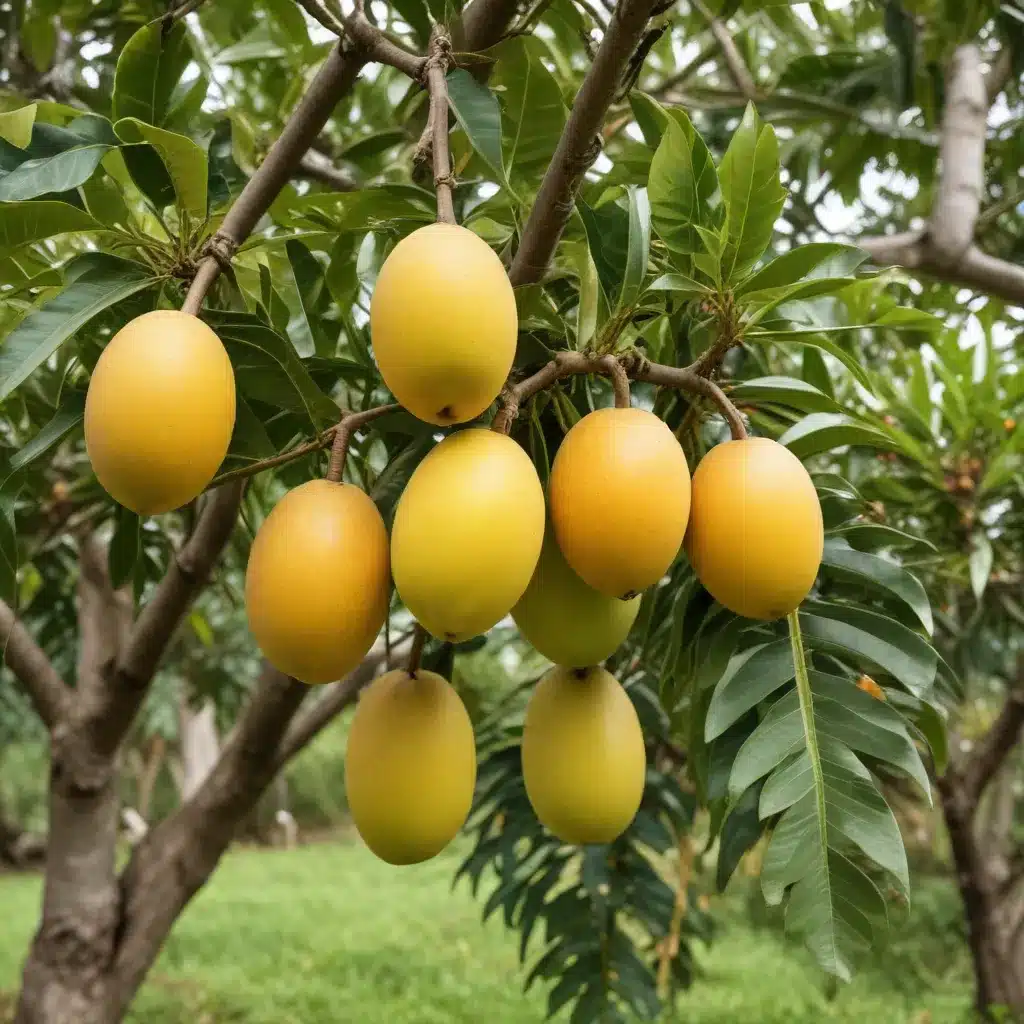
Cultivating tropical fruit trees like mangoes in South Florida requires a nuanced approach to fertilization. These resilient plants have specific nutritional needs that must be met to ensure robust growth, consistent fruiting, and resilience against common pests and diseases. As an experienced tree care specialist, I’ll share proven strategies for nourishing your mango trees and other exotic fruit varieties native to subtropical climates.
Soil Considerations for Tropical Fruits
The foundation for healthy, productive tropical fruit trees starts with the soil. Mangoes, guavas, papayas, and other species thrive in well-drained, slightly acidic soils rich in organic matter. South Florida’s sandy, alkaline native soils often need amendments to achieve the optimal pH range of 5.5 to 7.0.
Regular soil testing is crucial to identify any nutrient deficiencies or imbalances. Macronutrients like nitrogen (N), phosphorus (P), and potassium (K) are essential, while micronutrients such as iron, magnesium, and zinc play vital supporting roles. Incorporating composted organic matter can improve both nutrient levels and overall soil structure.
Selecting an appropriate planting site is also key. Tropical fruit trees require ample solar exposure and good air flow to ward off fungal diseases. Avoid low-lying areas prone to standing water, as these plants are highly sensitive to root rot and other moisture-related issues.
Fertilization Strategies
Timing and Application Methods
The annual fertilization regimen for mangoes and other tropical fruits typically involves multiple applications timed to the plant’s growth cycle. In South Florida, the first feeding should occur in early spring, just as new growth emerges. Follow up with supplemental applications every 2-3 months through late summer.
When applying granular fertilizers, distribute the product evenly across the root zone, extending slightly beyond the tree’s canopy drip line. Liquid or water-soluble formulas can be applied via drip irrigation systems for more targeted, efficient delivery. Whichever method you choose, always water thoroughly after fertilizing to help the nutrients penetrate the soil.
Nutrient Requirements for Mangoes
Mangoes have particularly high nitrogen requirements, needing about 0.5-1 lb of actual N per inch of trunk diameter annually. A balanced NPK fertilizer with a ratio around 10-5-10 or 12-4-12 works well. Supplement this with additional applications of potassium, which supports fruit production and enhances the tree’s cold tolerance.
Micronutrient deficiencies, especially of iron and zinc, can also plague mangoes. Look for specialized mango or tropical fruit tree formulas that include these essential minerals. Foliar sprays may be necessary if soil-applied treatments prove inadequate.
Supplementary Amendments
Beyond the primary NPK blend, tropical fruit trees often benefit from periodic applications of supplemental amendments. Dolomitic lime can help neutralize overly acidic soils, while gypsum improves drainage and calcium levels. Seaweed extracts and humic acids provide a boost of organic matter and beneficial microbes.
For established trees, a trunk injection with nutrients or systemic fungicides can be an effective treatment for specific issues. This specialized application method bypasses the roots to deliver compounds directly into the vascular system.
Planting and Establishment
When establishing new tropical fruit trees, it’s crucial to select healthy, disease-free nursery stock. Inspect the root system for any signs of damage or circling roots, which can hinder long-term growth. Carefully transplant the tree, ensuring the root ball sits at the same depth it was growing at the nursery.
Provide ample irrigation during the first year, keeping the soil consistently moist but not waterlogged. Newly planted trees also benefit from a 2-4 inch layer of organic mulch around the base, which helps retain moisture and suppress weeds.
Tropical Storm Preparedness
South Florida’s tropical climate brings the constant threat of powerful storms. Proper hurricane preparation is essential for safeguarding your valuable fruit trees. Prune away any dead, damaged, or rubbing branches to reduce the canopy’s wind resistance. Ensure the root zone is well-anchored with deep, flaring roots. If possible, stake young trees to prevent blowdowns.
After a major storm, carefully inspect for any broken limbs or other damage. Prune out affected areas and apply fungicidal dressings to protect against disease. Restore optimal soil moisture levels and consider a supplemental fertilizer application to stimulate regrowth.
Alternative Tropical Fruit Varieties
While mangoes are undoubtedly the most widely grown tropical fruit tree in South Florida, they’re not the only option. Guavas, papayas, lychees, and avocados all thrive in our warm, humid climate and offer unique flavors and uses. Each species has its own specific nutritional needs, so be sure to research the appropriate fertilization regimen.
Citrus fruits like key limes, kumquats, and various mandarin oranges also do well in South Florida, though they tend to prefer a slightly more alkaline soil environment. Explore the wide world of exotic tropical produce to diversify your home orchard!
Pest and Disease Management
No discussion of tropical fruit tree cultivation would be complete without addressing common pests and diseases. Mangoes are particularly susceptible to mango leafhoppers, mango scale, and a host of fungal pathogens like anthracnose and powdery mildew. Proactive integrated pest management (IPM) practices, including cultural controls, biological agents, and judicious use of pesticides, are essential.
Regular monitoring, proper pruning techniques, and improving air flow around the canopy can go a long way in preventing and mitigating many tropical fruit tree ailments. Consult with your local South Florida Trees arborist for personalized guidance on addressing specific issues.
Cultivating a thriving tropical fruit orchard in South Florida takes dedication and an understanding of these unique plants’ specialized needs. By tailoring your fertilization regimen, optimizing soil conditions, and practicing proactive pest and disease management, you can enjoy bountiful harvests of mangoes, guavas, and other exotic delights for years to come. With the right strategies in place, your backyard oasis will flourish, even in the face of challenging environmental conditions.


